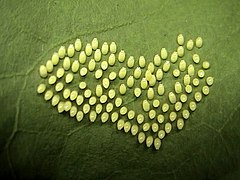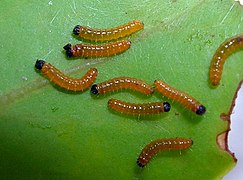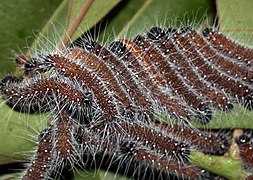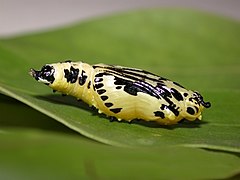Delias eucharis
| Delias eucharis | ||||||||||||
|---|---|---|---|---|---|---|---|---|---|---|---|---|

Delias eucharis |
||||||||||||
| Systematics | ||||||||||||
|
||||||||||||
| Scientific name | ||||||||||||
| Delias eucharis | ||||||||||||
| ( Drury , 1773) |
Delias eucharis is occurring in Asia Butterfly ( butterfly ) from the family of Whites (Pieridae).
features
butterfly
The moths reach a wingspan of 65 to 85 millimeters. In both sexes, the black veins stand out clearly from the pure white upper sides of the wing and shine through to the also white underside of the forewing. The distinctively colored rear wing base is located in the basal, Diskal- and Postdiskalregion yellow, indicating the Submarginalregion a chain of red spots on a black background, long pointed to the hem. This brightly colored color is to be understood as a warning color and makes it clear to potential predators that the moths are inedible due to the toxins taken from the food during development.
Egg, caterpillar, pupa
The elongated eggs are yellowish. The newly hatched caterpillars are glassy, brown in color and have very thin, short hairs and a shiny black head. When fully grown, they take on a red-brown color and are covered with thin, long white hairs over the entire surface of the body. The doll is designed as a belt doll and has a creamy white to light yellow color. On the abdomen and on the wing sheaths, more or less strongly developed black-brown stripes and points can be seen.
Similar species
- Prioneris sita differs in that the red spots on the underside of the hind wing run out flat at the edge and the hind wings are broader overall. The rest of the drawing is very similar to Delias eucharis and is an example of a typical mimicry . Prioneris sita is non-toxic, but is usually not attacked by predators, such as birds, as it is believed to be the poisonous Delias eucharis .
- The moths of Delias hyparete show a stronger black coloration on the edge of the hind wings and in the area around the tip of the forewings .
distribution and habitat
The distribution of Delias eucharis extends through India . The species is also found in Burma , Thailand , Indonesia and Sri Lanka . It inhabits flat, open and wooded as well as hilly areas up to altitudes of 1500 meters, subtropical rainforests and can also be found in urban gardens and parks.
Way of life
The moths fly in several generations throughout the year. They like to suckle on flowers for food intake, for example on convertible herb ( Lantana ) or mint species ( Mentha ). In contrast to Prioneris sita , however, they rarely visit humid places in the earth. The eggs are laid in numbers on the underside of the leaves of the food plant. The caterpillars are sociable and feed on the leaves of various belt flowers (Loranthaceae), preferably mistletoe species . The females in particular like to stay in higher tree regions because the food plants also grow there. Toxic components of food are stored in the body, which means that the adults are inedible for many predators. When visiting flowers, however, they are sometimes overwhelmed and sucked out by crab spiders (Thomisidae).
Individual evidence
- ↑ Information on Art
- ↑ Markku Savela: Tanaecia Butler (1869) - distribution. In: Lepidoptera and some other life forms. Accessed January 13, 2019 .
Web links
- Lepiforum e. V. - Taxonomy and photos
- ifoundbutterflie - Butterflies of India
- learnaboutbutterflies - Common Jezebel







